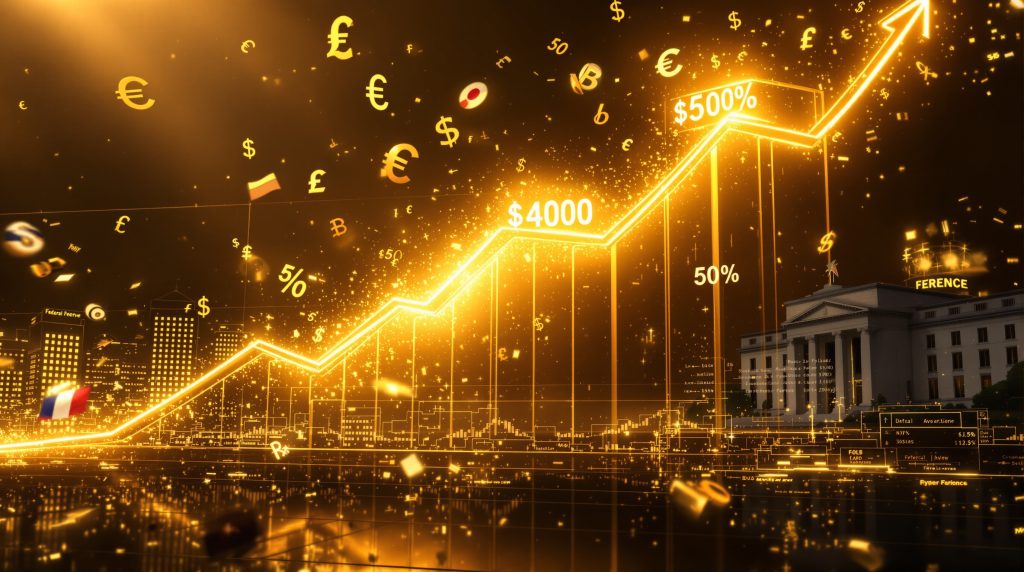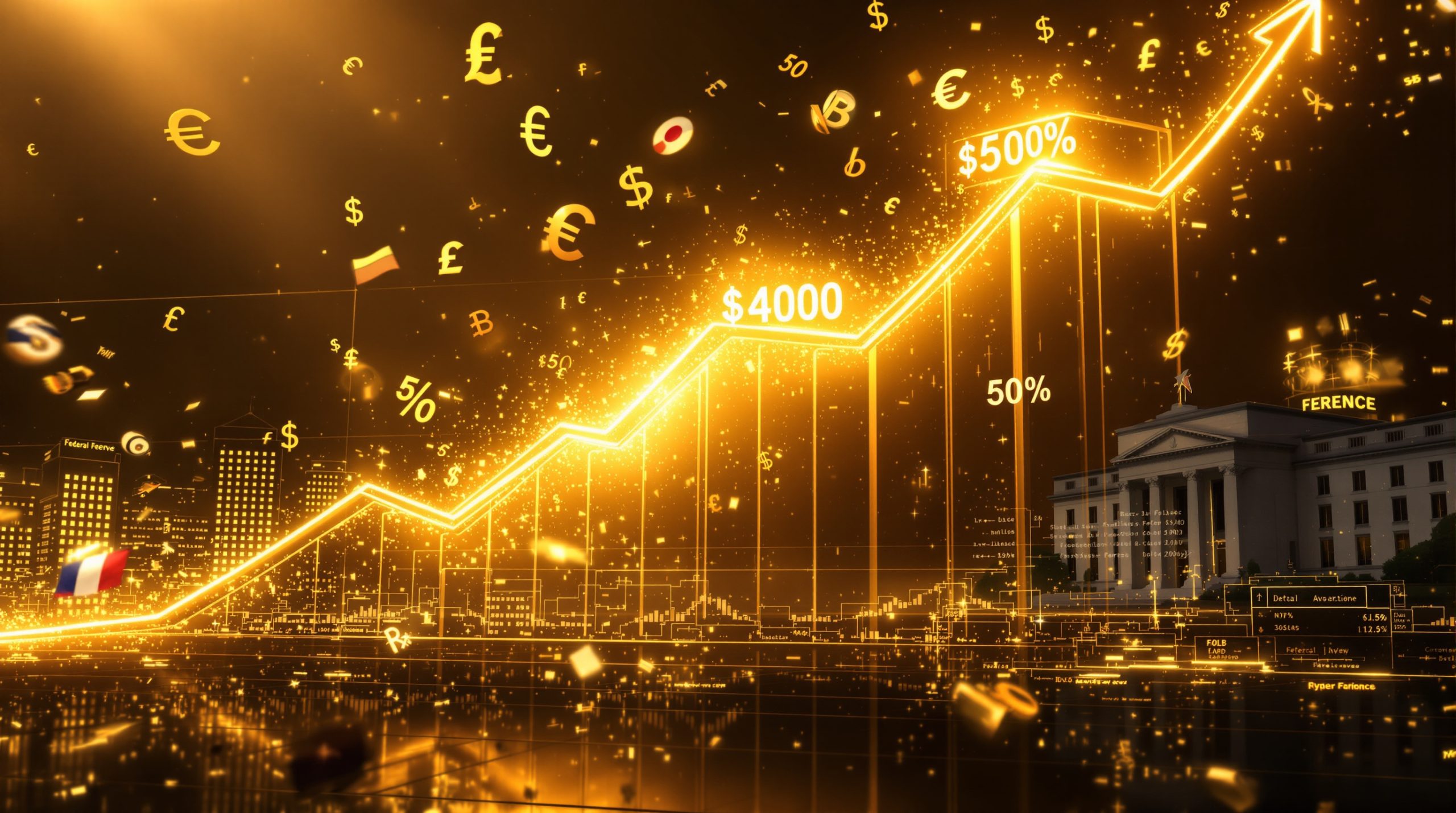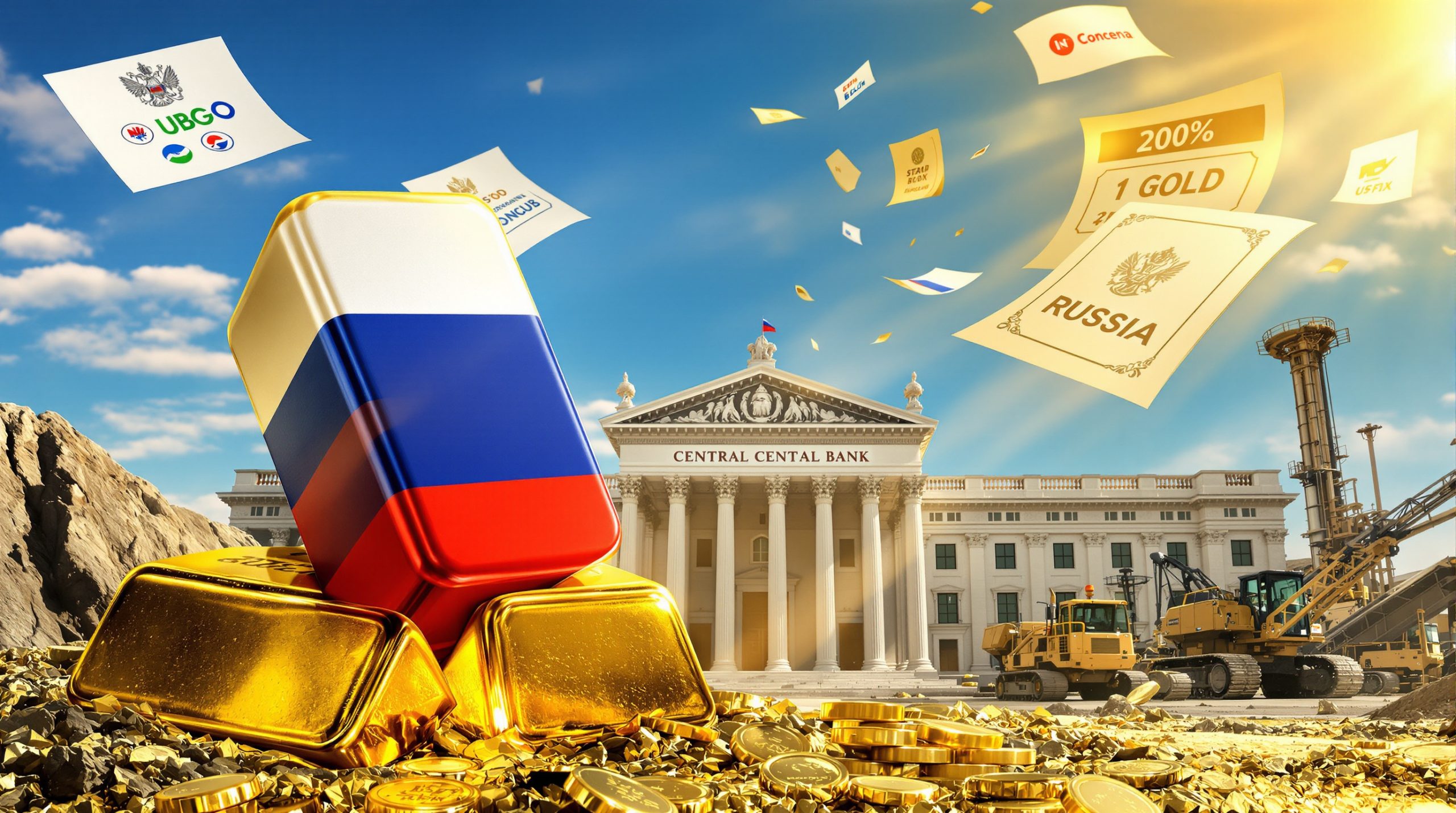The Historic Gold Rally: Breaking the $4,000 Barrier
Gold prices have made history by crossing the remarkable $4,000 per ounce threshold, creating shockwaves throughout global financial markets. This unprecedented milestone represents a fundamental shift in how investors view precious metals in times of economic uncertainty. The meteoric rise of gold prices—increasing by approximately 50% since January—has caught the attention of institutional investors, central banks, and individual traders alike.
The precious metal reached a peak of $4,050 per ounce in October 2025, shattering previous records and defying many analysts' earlier predictions. This extraordinary all-time high analysis has positioned gold as the standout investment asset of the year, outperforming most traditional markets including equities and bonds.
Analyzing the Unprecedented Price Movement
Several key metrics highlight the exceptional nature of this gold rally:
- Record Price Point: The $4,050 per ounce mark represents uncharted territory for gold markets
- Rapid Acceleration: Nearly 12% price appreciation in just the past month
- Yearly Performance: Over 50% increase from January levels
- Historical Context: The fastest rate of appreciation since the 2008 global financial crisis
- Trading Volume: Significant increases in futures contract activity across major exchanges
Market analysts note that gold typically performs well during times of uncertainty, but the current market surge performance stands out for both its speed and magnitude. The precious metal has efficiently fulfilled its traditional role as a safe-haven asset during this period of global economic instability.
What Global Uncertainties Are Fueling Gold's Rise?
The gold market's dramatic response comes amid a convergence of global uncertainties that have eroded investor confidence in traditional markets. This perfect storm of destabilizing factors has pushed capital toward safe-haven assets, with gold being the primary beneficiary.
Political Instability Creating Market Anxiety
Political developments across major economies have significantly contributed to market anxiety. Government transitions and policy uncertainties have created ripple effects throughout global financial centers. These political disruptions have undermined investor confidence in traditional markets, making gold's stability increasingly attractive.
The combination of these political factors has heightened perceptions of global instability, driving investors toward gold as a dependable store of value. Market analysts suggest this flight to safety reflects deep concerns about the potential economic impacts of governmental changes and policy shifts.
US Economic Challenges Amplifying Gold Appeal
Domestic economic challenges in the United States have further enhanced gold's appeal. Concerns regarding potential government funding gaps have created uncertainty about the timely release of critical economic data. This information vacuum has heightened market anxiety and made economic forecasting more challenging.
Additionally, market observers have noted growing debates about monetary policy independence, raising questions about future economic management. These factors have collectively applied pressure to the US dollar, enhancing gold's relative value as an alternative asset.
The relationship between gold and the dollar typically operates as an inverse correlation—when the dollar weakens, gold often strengthens. This relationship has been particularly pronounced during the current gold price surge, with gold reaching new heights as the dollar faces multiple headwinds.
How Are Central Banks Influencing the Gold Market?
Central banks worldwide have emerged as major drivers in the current gold rally through their strategic purchasing decisions and policy shifts.
Strategic Gold Accumulation by Global Monetary Authorities
Global monetary authorities have been systematically increasing their gold reserves throughout 2025. This institutional buying represents a calculated strategy to:
- Diversify reserves away from traditional currency holdings
- Create a hedge against potential economic sanctions
- Protect against persistent inflation concerns
- Establish more autonomous monetary positioning
The scale of central bank purchases has created substantial baseline demand in the gold market. This institutional buying has helped establish a solid price floor while contributing to the upward price momentum.
Monetary Policy Shifts Supporting Higher Valuations
The anticipated shift toward monetary easing by major central banks, particularly the Federal Reserve, has dramatically altered gold's investment proposition. Market expectations now center on multiple interest rate reductions, with significant cuts anticipated before year-end. This shift in monetary policy creates several favorable conditions for gold:
- Reduced opportunity cost for holding non-yielding assets
- Decreased attractiveness of interest-bearing investments
- Potential for currency devaluation that enhances gold's relative value
- Increased inflation hedge benefits that strengthen gold's appeal as a hedge
These policy developments have created an exceptionally supportive environment for gold prices, contributing significantly to the current rally.
Why Are Individual Investors Flocking to Gold?
While institutional players have driven much of the demand, individual investors have also played a crucial role in gold's recent performance.
Wealth Preservation in Uncertain Times
Retail investors have increasingly turned to gold as a wealth preservation strategy amid growing concerns about market stability. This trend reflects gold's historical role as a store of value during periods of economic turbulence.
Individual investors appear particularly motivated by:
- Concerns about inflation eroding purchasing power
- Uncertainty regarding traditional retirement investments
- Desire for tangible assets during financial volatility
- Loss of confidence in government-issued currencies
- Wealth protection during potential market corrections
Financial advisors report increased client interest in gold allocation strategies, with many recommending 5-15% portfolio exposure to precious metals as a diversification measure.
Gold vs. Traditional Investments in the Current Climate
With interest rates poised to decline, gold has gained significant appeal compared to conventional investment vehicles:
| Investment Type | Current Yield/Return | Inflation Protection | Volatility | Liquidity |
|---|---|---|---|---|
| Savings Accounts | Low | Poor | Very Low | High |
| Government Bonds | Moderate | Limited | Low-Moderate | High |
| Corporate Bonds | Moderate-High | Limited | Moderate | Moderate |
| Equities | Variable | Partial | High | High |
| Gold | Non-yielding | Strong | Moderate | High |
The anticipated interest rate cuts have eliminated one of gold's traditional disadvantages—its lack of yield—by reducing returns on competing assets. As rates decline, gold's opportunity cost diminishes, making it increasingly attractive to investors seeking both preservation and potential appreciation.
Is the Gold Rally Sustainable?
Despite the remarkable price surge, market observers remain divided on gold's prospects for continued appreciation.
Warning Signs of Potential Correction
Some financial analysts have urged caution about gold's near-term trajectory. Technical indicators suggest the rally may be approaching natural limits, with several warning signs emerging:
- Overbought conditions on momentum indicators
- Historically extended price-to-moving-average ratios
- Futures market positioning showing extreme bullishness
- Widening gap between spot and futures prices
- Unusual options market activity suggesting hedging
Some financial institutions have raised concerns about "uptrend exhaustion," suggesting the rally may need a period of consolidation or correction before establishing a new sustainable trajectory. This analysis indicates the possibility of a significant pullback later in 2025, which could temporarily reverse some recent gains.
Long-Term Outlook for Gold Prices
While short-term corrections remain possible, the fundamental drivers supporting elevated gold prices appear robust. The combination of geopolitical instability, monetary policy easing, and persistent inflation concerns creates a supportive backdrop for gold prices beyond any potential near-term pullbacks.
Several structural factors suggest continued long-term strength:
Mining production constraints limit new supply growth, with global production increasing by less than 1% annually while demand continues to rise. This fundamental supply-demand imbalance supports higher equilibrium prices over time.
Long-term investors may view any corrections as potential buying opportunities rather than reasons to exit the market entirely. Portfolio managers increasingly recommend maintaining gold exposure as a strategic asset class rather than a tactical trading position.
How Does This Rally Compare to Historical Gold Bull Markets?
The current gold rally exhibits both similarities and differences when compared to previous bull markets in the precious metal.
Historical Context for the Current Surge
The present gold rally stands out for both its velocity and magnitude when compared to previous bull markets:
- 1970s Bull Market: Gold rose approximately 1,500% following the end of the gold standard, driven primarily by inflation concerns
- 2008-2011 Rally: Prices increased about 160% during the global financial crisis and subsequent quantitative easing
- 2019-2020 Move: Gold gained roughly 40% amid pandemic uncertainty and monetary stimulus
- Current Rally: The 50% single-year increase represents one of the most aggressive upward movements in modern gold trading history
The speed of the current price appreciation is particularly noteworthy, with gold achieving in months what previously took years during past bull markets.
Key Differences from Previous Price Surges
Unlike previous rallies that were often driven by singular events, the current surge reflects a complex convergence of multiple factors:
- Broader Participation: Today's rally features unprecedented coordination between institutional, central bank, and retail investors
- Digital Access: Modern trading platforms have democratized gold investment, allowing wider market participation
- Derivative Markets: Sophisticated financial instruments have amplified price movements through leveraged exposure
- Information Flow: Real-time market data has accelerated investor reactions to economic developments
- Global Uncertainty: The simultaneous occurrence of multiple destabilizing factors has created stronger flight-to-safety dynamics
This multi-faceted foundation potentially gives the current rally greater resilience than historical precedents, though it also creates more complex market dynamics.
What Are the Economic Implications of $4,000 Gold?
Gold's dramatic price surge serves as more than just a market phenomenon—it functions as an economic barometer with significant implications.
Inflation Signals and Economic Warning Signs
Gold's performance suggests market participants remain deeply concerned about price stability despite official narratives. As a traditional inflation hedge, gold's rally reflects significant anxiety about:
- Currency Devaluation: Eroding purchasing power of fiat currencies
- Central Bank Credibility: Questions about monetary authorities' ability to control inflation
- Financial System Stability: Underlying concerns about systemic risks
- Economic Growth Prospects: Signals of potential economic contraction ahead
Economists often view extreme gold price movements as market-based indicators of underlying economic concerns that may not yet be fully reflected in official data or policy discussions.
Impact on Related Industries and Markets
The gold price surge has created ripple effects throughout adjacent industries:
- Mining Sector: Gold mining companies have seen substantial valuation increases, with the NYSE Arca Gold Miners Index up approximately 45% year-to-date
- Jewelry Manufacturing: Producers face margin pressures from higher input costs, forcing innovation in alloy formulations and designs
- Technology Sector: Electronics manufacturers that rely on gold for components are experiencing increased production costs
- Investment Products: Gold-backed ETFs have seen record inflows as investors seek exposure without physical storage requirements
- Related Commodities: Silver, platinum, and other precious metals have experienced sympathetic price movements
These sectoral impacts illustrate how gold's performance extends beyond trading desks to affect tangible industries and economic activities globally.
FAQs About the Gold Price Surge
What factors are driving gold above $4,000?
The unprecedented gold rally stems from a perfect storm of factors including global political instability, concerns about government fiscal policies, aggressive central bank buying, anticipated interest rate cuts, and investors seeking safe-haven assets amid market uncertainty. This convergence of multiple supportive factors has created extraordinary upward pressure on gold prices.
Will gold prices continue rising through 2025?
While some technical analysts warn of potential short-term corrections, the fundamental drivers supporting elevated gold prices—including geopolitical tensions, monetary easing, and inflation concerns—suggest long-term support for higher valuations despite possible volatility. Investors should prepare for potential consolidation phases while maintaining awareness of the strong structural factors supporting the market.
How are interest rates affecting gold prices?
The expected monetary policy easing has significantly boosted gold's appeal. As interest rates decline, the opportunity cost of holding non-yielding gold diminishes substantially compared to increasingly low-yielding bonds and savings accounts. This relationship between interest rates and gold prices represents one of the most reliable correlations in financial markets.
What does the gold rally indicate about the global economy?
Gold's surge serves as a market barometer of economic unease, reflecting deep concerns about inflation persistence, currency stability, and overall economic health. The rally suggests investors are actively seeking wealth preservation assets amid growing uncertainty about traditional financial markets and government economic management.
Gold as the Global Barometer of Economic Confidence
The historic surge in gold prices beyond $4,000 per ounce represents far more than a simple commodity rally. It serves as a powerful market signal reflecting diminished confidence in traditional financial systems and growing anxiety about global economic stability. As gold continues its remarkable ascent, it reinforces its centuries-old role as humanity's ultimate financial refuge during periods of uncertainty—shining brightest precisely when other markets falter.
The precious metal's performance through 2025 demonstrates that despite all the technological and financial innovations of the modern era, gold retains its unique psychological and practical appeal as the world's most enduring store of value. Whether this rally continues or faces correction, gold's response to current global conditions provides valuable insights into market psychology and economic sentiment that extend far beyond the precious metals sector.
For investors navigating these uncertain waters, gold's message is clear: market participants are seeking safety and stability in an increasingly unpredictable world. The path forward may involve volatility, but gold's enduring appeal during times of uncertainty suggests its role in the global financial system remains as relevant as ever. Those looking for detailed price forecast outlook and investment strategies analysis should carefully consider both short-term technical indicators and long-term fundamental drivers before making allocation decisions.
Want to Profit from the Next Major Gold Discovery?
Capitalise on real-time alerts for significant ASX mineral discoveries with Discovery Alert's proprietary Discovery IQ model, turning complex gold exploration data into actionable investment opportunities. Explore how historic gold discoveries have generated substantial returns by visiting the dedicated discoveries page and begin your 30-day free trial today.




